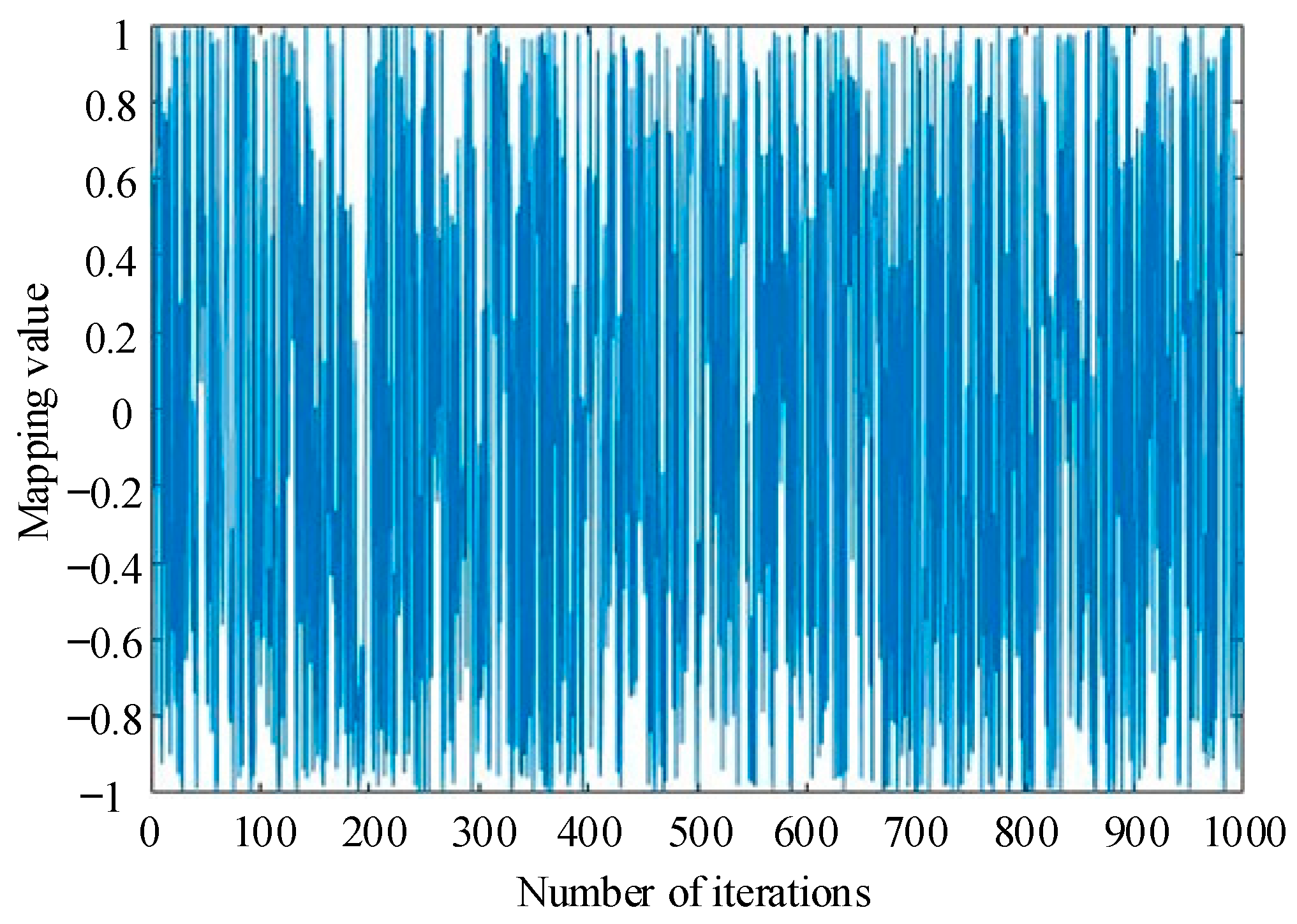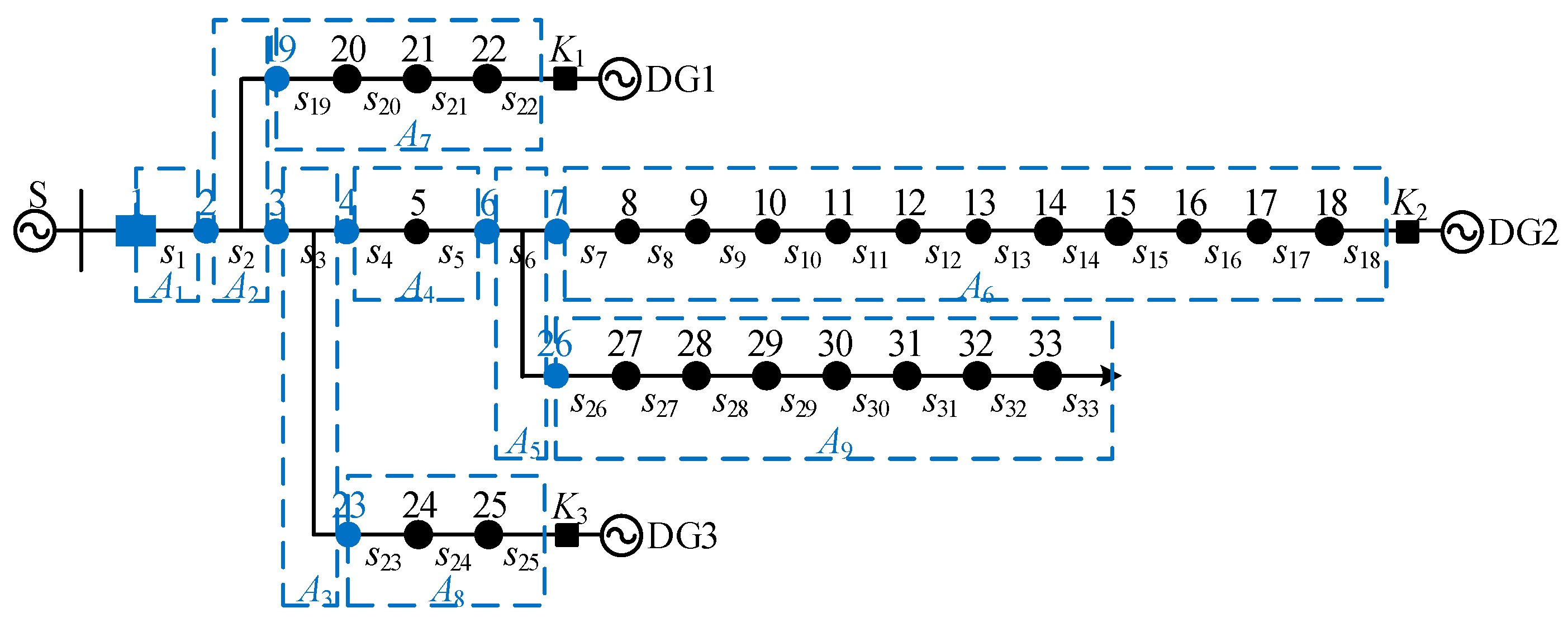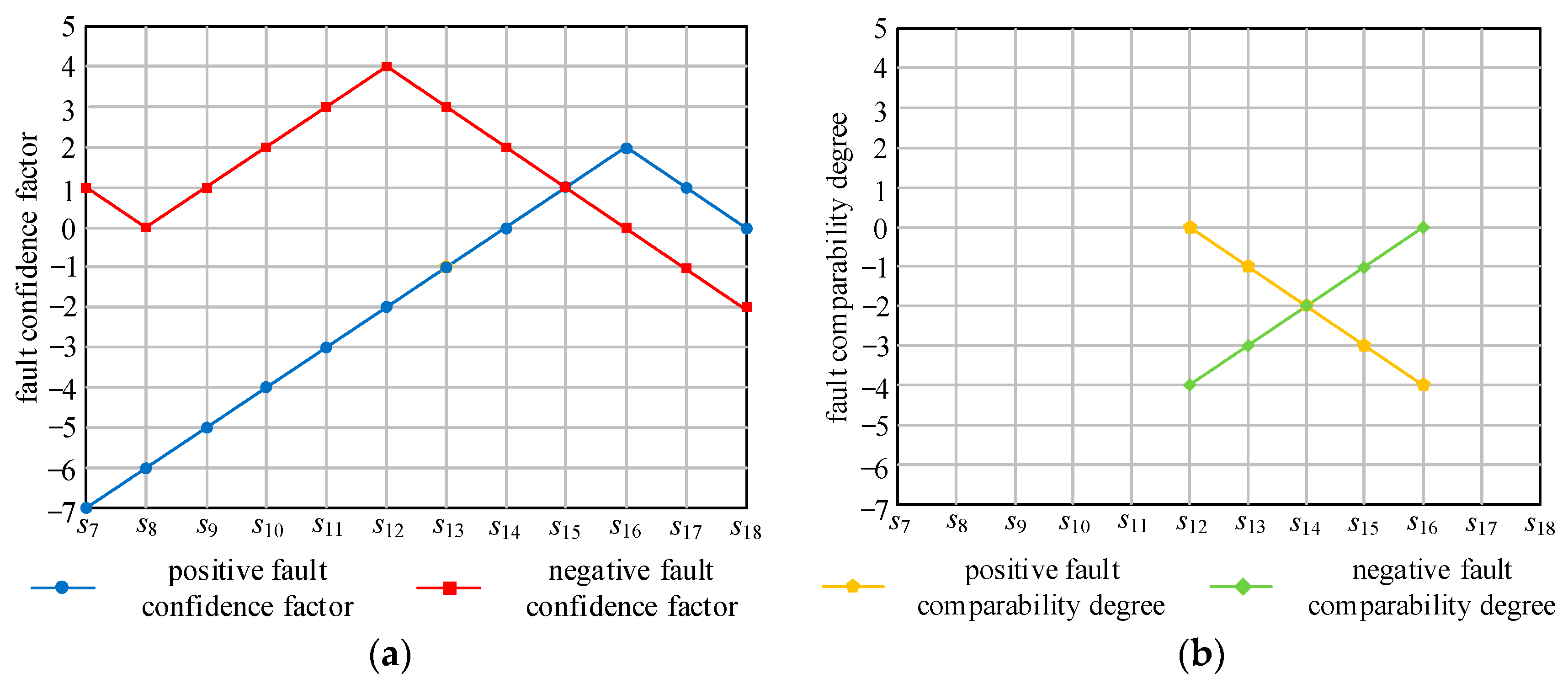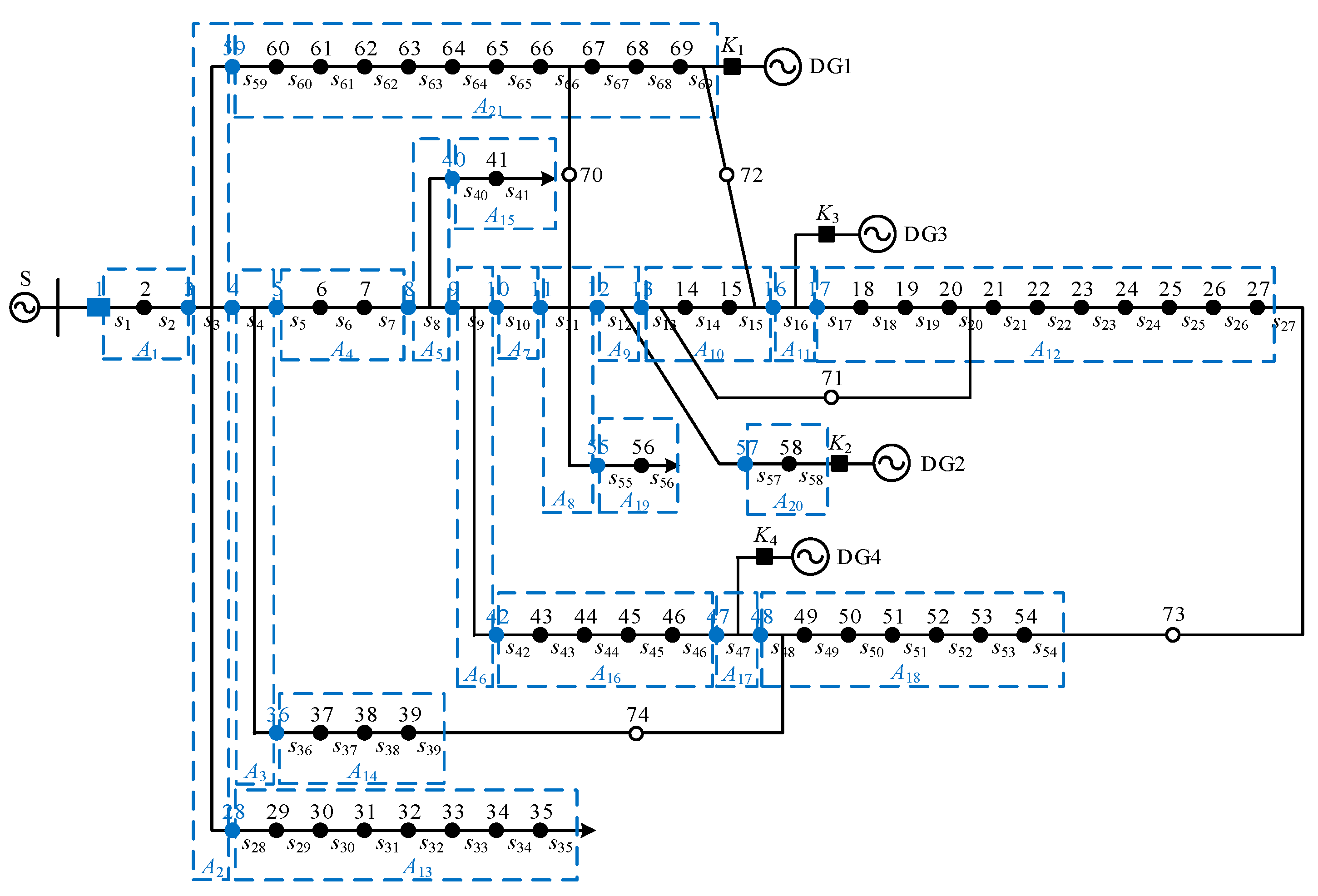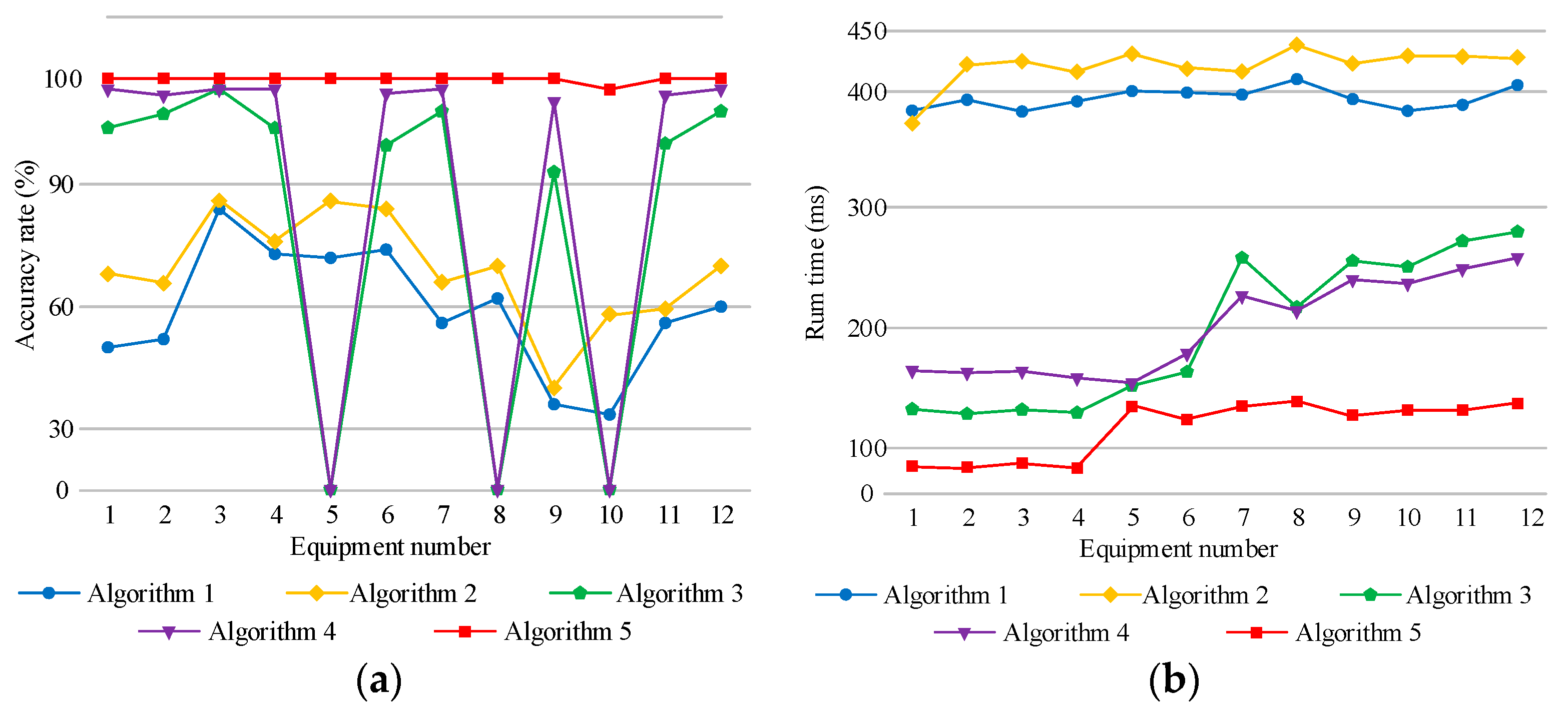In the above example, we can see that the size of the solution space of the fault location problem is exponentially related to the number of sections in the distribution network. Assuming that the number of feeder sections of the network is m, it is theoretically necessary to assume 2m kinds of failure scenarios Therefore, it needs to search for the optimal solution from 2m X. With the expansion of the network size, the fault search dimension increases. This can seriously affect the computational efficiency and accuracy of fault location.
In order to solve the above problems, this section proposes an area delimitation method based on the analysis of the logical law of the switching function. It then constructs a hierarchical optimization model for fault location by taking the T-section as the boundary, transforming the single high-dimensional calculation into two low-dimensional location operations and effectively reducing the fault search dimension.
2.2.1. Theoretical Basis of Area Delineation
Take the distribution network shown in
Figure 2 as an example for analyzing the theoretical basis of area division. The distribution network shown in
Figure 2 is divided into three branches by T-type section
s4:
L1,
L2, and
L3. Among these,
L1 contains sections
s1~
s3,
L2 contains sections
s5~
s7, and
L3 contains sections
s8~
s10. Branch
L2 is taken as an example, and the value law of the switching functions of nodes on branch
L1 and
L3 when a fault occurs in sections
s5~
s7 is analyzed. Assume that the DG is connected to the distribution network for operation.
(1) Let node
j be any node on branch
L1; assume set
. According to Equation (3):
Define the variable
to indicate the running status of branch
L2.
According to Equation (2), the operational state variables
x5,
x6, and
x7 represent the running states of sections
s5,
s6, and
s7, respectively. Evidently,
is related to
x5~
x7 as follows:
When a fault occurs in branch
L2, no matter which fault occurs in any section of
s5~
s7, all have the following equation:
. According to Equation (6):
Equation (9) does not contain the operational state variables x5, x6, and x7 of sections s5, s6, and s7. It follows that branch L2 has the same effect on the switch function of nodes on branch L1 regardless of the specific location of the fault section, as long as the fault is on branch L2.
(2) Let node
i be any node on branch
L3, according to Equation (3):
When a fault occurs in branch
L2,
, regardless of the specific location and number of fault sections inside branch
L2. According to Equation (10):
Equation (11) does not contain the operational state variables x5, x6, or x7 of sections s5, s6, and s7. It follows that branch L2 has the same effect on the switch function of nodes on branch L3 as long as the fault is on branch L2, regardless of the specific location of the fault section.
In summary, the various fault scenarios on branch L2 have the same effect on the switching functions of nodes on other branches. Therefore, according to the principle of port equivalence, the sections s5~s7 on branch L2 can be equated to a two-port, which is called area A2.
Similarly, the sections s1~s3 on branch L1 and the sections s8~s10 on branch L3 can be equated to two ports called area A1 and area A3, respectively.
2.2.2. Improved Method for Area Division
An ordinary section has two associated nodes that are connected to each other at the beginning and end to form a branch. The analysis in
Section 2.2.1 shows that a fault in an ordinary section on the same branch has the same effect on the switching functions of other branches; therefore, the ordinary sections can be externally equivalent to a two-port in terms of a branch. However, the T-section has more than two associated nodes and can receive short-circuit power from multiple directions. Therefore, there is power coupling with multiple branches. Unlike an ordinary section, the effect of a fault in a T-section on the switching functions of nodes on other branches is therefore more special.
For illustration, take node 10 on branch
L3 as an example. Assuming that the DG is connected to the distribution network for operation, the switching function of node 10 is shown in Equation (12), according to Equation (3):
First, the effect of the ordinary section failure is analyzed. Ordinary sections
s1~
s3 on branch
L1 are on the path from node 10 to the main power supply. When a section in
s1~
s3 fails, the short-circuit power provided by the main power supply to node 10 will be truncated, but node 10 can still receive the short-circuit power provided by the DG from the path DG → s7 → s6 → s5 → s4 → s8 → s9, so the switching function of node 10 at this time is related to the operation status of other sections. According to Equation (12), the switching function of node 10 at this time is as shown in Equation (13):
From Equation (13), when s4 and s8 are running normally and branches L1 and s10 fail simultaneously.
Next, the effect of T-section failure is analyzed. Since section
s4 is simultaneously on the path from node 10 to the main power supply and the DG, the short-circuit power supplied by both the main power supply and DG to node 10 is truncated when a fault occurs in
s4. According to Equation (12), the switching function of node 10 at this time is shown as follows:
From Equation (14), it can be seen that when s4 fails, the switching function of node 10 will be constantly equal to 0, regardless of the operating state of the other sections.
It can be seen that the failure of an ordinary section and the failure of a T-section on a branch have different effects on the switching functions of the nodes on other branches. This is because s4 is associated with branches L1, L2, and L3, and plays the role of pooling and distributing the power on branches L1, L2, and L3. In this paper, this is called the power coupling phenomenon of the T-section.
If the T-section and its associated branch are externally equivalent to the same two-port, it may lead to a misjudgment of some fault situations. Take the distribution network shown in
Figure 2 as an example: the traditional hierarchical model treats branch
L1 near the main power side and the T-section
s4 as the same external two-port [
24,
25]. However, when a fault occurs simultaneously in the upstream branch
L1 and the downstream branch
L3 of the T-type section
s4, the algorithm will treat the fault of
L1 as equivalent to the fault of
s4 because the branch L1 and T-type section
s4 are located in the same port, resulting in the switching functions of nodes 8~10 being constantly equal to 0; this cannot identify the fault section on the downstream branch
L3, resulting in a missed diagnosis. Therefore, considering the power coupling phenomenon, T-type section
s4 should be independently equated to a two-port, which is denoted as area
A4.
In summary, this paper proposes an area partitioning method with a T-section as the boundary. This method divides the distribution network into multiple areas by taking the associated nodes of the T-sections as the boundary. Taking the distribution network shown in
Figure 2 as an example, the distribution network is divided into four areas with the association nodes 4, 5, and 8 of T-section
s4 as boundaries, as shown in
Figure 3. Here, the port nodes and area are marked in blue. Each area contains port nodes, internal nodes, and feeder sections, as shown in
Table 2.
From
Table 2, it can be seen that the area division method proposed in this paper treats the T-sections as independent areas to achieve the decoupled identification of the T-sections and branch faults and avoid misjudgment of the fault condition. Take the above fault condition as an example: when the upstream branch
L1 and the downstream branch
L3 of T-section
s4 occur at the same time, the switch function of the nodes on
L3 will not be misjudged as 0 because the branch
L1 and the T-section
s4 are not in the same port and can accurately reflect the fault condition, providing a prerequisite for the accurate identification of the fault.
It should be noted that, according to the distributed generation grid connection protocol, DGs can be connected to the network not only through the system side bus or the end of the supply but can also operate with a “T” type connection directly in the middle section of the feeder. Although the T-connection point of a DG is only associated with two nodes, it is the same as the T-type section,, which plays the role of the convergence and distribution of power in multiple directions; therefore, the same power coupling phenomenon exists. It can be proved that the fault of the DG “T” connection point and its upstream and downstream branches have different effects on the switching functions of the nodes on other branches. Therefore, the DG “T” connection point should be regarded as a T-type section for dividing the distribution network area. As shown in
Figure 4, the distribution network is divided into three areas,
A1,
A2, and
A3, using the T-connection point of the DG
s4 as the T-section.
A1,
A2, and
A3 contain sections
s1~
s3,
s4, and
s5~
s7, respectively. The results of the area division are shown in
Figure 4. In
Figure 4, the port nodes and areas are marked in blue.
2.2.3. Hierarchical Optimization Model
Based on the division of the distribution network area, this section proposes a hierarchical optimization model for fault location which divides the fault location operation into two levels: the first level locates the fault area and extracts the fault information of the port node to determine the area where the fault is located. It uses the feeder section contained inside the fault area as the solution space of the second level. The second level locates the fault section and extracts the fault information of the node inside the fault area to determine the feeder section where the fault occurs.
Take the distribution network shown in
Figure 2 as an example to illustrate the fault location process and dimensionality reduction effect of the hierarchical model. Suppose a fault occurs in section
s3; the FTU uploads the fault information to the SCADA system, and the fault location operation commences. First, the operation states of areas
A1~
A4 are used to form the solution space, the fault information of port nodes 1, 4, 5, and 8 is extracted to locate the fault area, and the fault area is determined to be
A1. Since each area has two operation states—fault and normal—the fault search dimension of the process is 2
4. On this basis, the solution space is composed of the operating states of the feeder sections
s1~
s3 inside the fault area
A1, and the fault information of nodes 1~4 is extracted for the fault area location; finally,
s3 is determined as the fault section. Correspondingly, the fault search dimension of this process is 2
3. In summary, the fault search dimension of the hierarchical model in the above fault condition is 2
4 + 2
3 = 24. In contrast, the traditional fault location method uses a single-layer fault location model which uses the operation states of section
s1~
s10 as the solution space to search for faults, and the fault search dimension is 2
10 = 1024. Thus, the fault search dimension is reduced by the hierarchical model by (1024 − 24)/1024 = 97.66%. In fact, the larger the scale of the distribution network, the more obvious the dimensionality reduction effect of the hierarchical model is. This provides theoretical support for improving the accuracy and computational efficiency of fault location.




